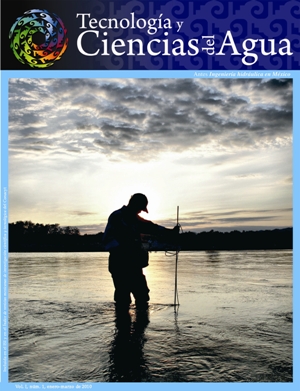Catastrophe models for the flow around immersed bodies.
DOI:
https://doi.org/10.24850/j-tyca-2010-01-01Keywords:
catastrophe theory applications, catastrophe theory, flow around immersed bodies, hysteresis in fluid mechanics, fluid mechanics, cusp catastropheAbstract
In fluid mechanics there are several phenomena that exhibit a hysteretic behavior and sudden changes not only of a quantitative, but also a qualitative nature. Such phenomena can be represented and explained by the catastrophe theory, which explains this kind of behavior observed in some physical systems. This article offers an analytical demonstration that the flow around immersed cylinders is a fold catastrophe. Extending this result, now with a semi-empirical approach, it can be shown that flow around cylinders and spheres with roughness can be represented using a cusp catastrophe geometry. Both results support the hypothesis that the flow around objects immersed in liquids can be modeled through catastrophe geometries and hence explain the occurrence of bifurcation, bimodality, sudden jumps and hysteresis.References
ACHENBACH, E. and HEINECKE, E. On vortex shedding from smooth and rough cylinders in the range of Reynolds numbers 6x103 to 5x106. Journal of Fluid Mechanics. Vol. 109, 1981, pp. 239-251.
ACHENBACH, E. Experiments of flow past spheres at very high Reynolds numbers. Journal of Fluid Mechanics. Vol. 54, Part 3, 1972, pp. 565-575.
ACHENBACH, E. The effects of surface roughness and tunnel blockage on the flow past spheres. Journal of Fluid Mechanics. Vol. 65, Part 1, 1973, pp. 113-125.
BIRKHOFF, G. Hydrodynamics: a study in logic, fact and similitude. Princeton: Princeton University Press, 1950.
CUI, P., THORES, J. and JUNWEI, G. Study on the properties of Debris flow initiation by means of catastrophe theory. Internationales Symposium Interprevent, Garnish-Partenkirchen, Germany, 1996, pp. 103-112.
DAILY, J.W. y HARLEMAN, D.R. Dinámica de los fluidos. México, D.F.: Trillas, 1975.
FAGE, A. and WARSAP, J.E. The effect of turbulence and surface roughness on the drag of a circular cylinder. Aero. Res. Counc., London, R&M, no. 1283, 1930.
KERNA, CH. and SURENDER, K. Application of stochastic catastrophe theory to reservoir management International conference on Interdisciplinary Mathematical and Statistical Techniques, May, 23-26, Czech Republic, 2009.
MARTÍNEZ-AUSTRIA, P. Procesos de catástrofe en hidráulica. Jiutepec, México: Instituto Mexicano de Tecnología del Agua, 1988, 330 pp.
MORSE, M. The critical points of a function of n variables. Trans. American Mathematical Society. Vol. 33, 1931, pp. 72-91.
SHEWE, G. On the force fluctuations acting on a circular cylinder in cross flow from subcritical up to transcritical Reynolds numbers. Journal of Fluid Mechanics. Vol. 133, 1983, pp. 265-285.
THOM, R. Structural stability and morphogenesis. New York: Benjamin-Addison Wesley, 1974. Traducido del francés Stabilité Structurelle et morphogénese, 1972.
Downloads
Published
How to Cite
Issue
Section
License
Copyright (c) 2010 Tecnología y ciencias del agua

This work is licensed under a Creative Commons Attribution-NonCommercial-ShareAlike 4.0 International License.
By Instituto Mexicano de Tecnología del Agua is distributed under a Creative Commons Attribution-NonCommercial-ShareAlike 4.0 International License. Based on a work at https://www.revistatyca.org.mx/. Permissions beyond what is covered by this license can be found in Editorial Policy.









